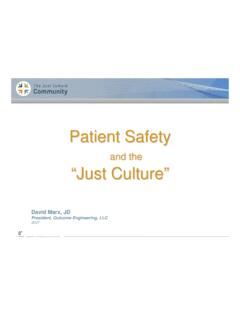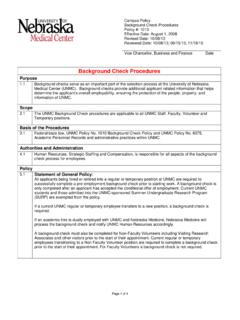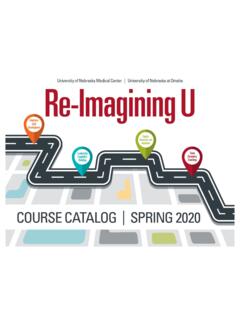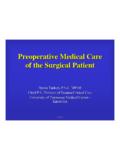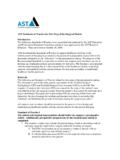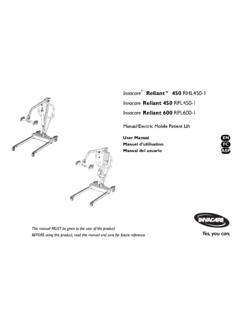Transcription of Best Practices in Safe Transfers and
1 best Practices in safe Transfers and Mobility to Decrease Fall Risk August 20, 2013 10 CSTCAPTUREC ollaboration and Proactive Teamwork Used to ReduceFallsDawn M. Venema, PT, PhDJill Hassel, DPTK atherine J. Jones, PT, PhDAcknowledgementThis project is supported by grant number R18HS021429 from the Agency for Healthcare Research and Quality. The content is solely the responsibility of the authors and does not necessarily represent the official views of the Agency for Healthcare Research and Quality. Describe current CAPTURE Falls event report statistics regarding types and effects of falls Discuss how principles of balance relate to falls Explain strategies to reduce patient fall risk during assisted Transfers and ambulation Explain strategies to improve patient stability in sittingLearning ObjectivesIntroductionPart 1: IntroductionTotal Reported Falls in CAPTURE Falls through July 2013 = 154 Unassisted76%(N = 117)Assisted24%(N = 37)Harm32%(N = 49)No Harm68%(N = 105)IntroductionRelationship Between Harm and AssistanceAssisted FallsN = 37 Harm19%(N = 7)No Harm 81%(N = 30)Unassisted FallsN = 117 Harm36%(N = 42)No Harm 64%(N = 75) IntroductionFive of the 49 harmful falls resulted in moderate* or severe** harm.
2 ALL five of these falls were unassisted.*moderate harm = Bodily or psychological injury adversely affecting functional ability or quality of life, but not at the level of severe harm**severe harm = Bodily or psychological injury (including pain or disfigurement) that interferes significantly with functional ability or quality of lifeIntroductionBasic Principles of Balance**also known as Postural ControlPart 2: Basics Principles of BalanceBase of Support (BOS) The area on which the body rests; The area that provides support for the body Larger BOS = More StabilityBasics Principles of BalanceNarrow Base Of SupportPhoto Credit: Base Of SupportCenter of Mass (COM)**also known as center of gravity (COG) The point at which the mass of the body is centered In an erect standing posture, the COM is located at the sacrum COM position moves with changes in body positionBasics Principles of BalancePhoto Credit: maximum distance an individual is able or willing to move their center of mass in any direction without loss of balance or changing the base of supportBasics Principles of BalancePhoto Credit: of Stability (LOS)BalanceBalance is the condition in which all the forces acting on the body are balanced in such a way that the center of mass (COM) stays within the limits of stability (LOS), which is dependent upon the base of support (BOS)Basics Principles of BalancePhoto Credit.
3 SimplifiedHow Do We Maintain our Center of Mass within our Limits of Stability?Sensory InputMotor OutputBasics Principles of BalanceBasics Principles of BalancePhoto Credit: transfer and Mobility TechniquesDisclaimer: The transfer techniques shown may need to be modified for specific patient diagnosesPart 3: safe transfer and Mobility TechniquesBasic Body Mechanics Principles:The safer you are, the safer your patient will be. Adjust the height of the bed as neededUse a wide base of supportMaintain the natural curves of your back Bend at your hips and knees insteadGet your center of mass close to your patient s center of massBody MechanicsMove or pivot your feet to turn; do not twist at your backAlways let your patient assist as much as possiblePerform transfer in a smooth motionIf more than 1 person is assisting, communicate Basic Body Mechanics Principles: The safer you are, the safer your patient will be. Body MechanicsPT Documentation: Level of Assistance Dependent:Patient requires total assistance Max Assist: Patient does 25%, Caregiver does 75% Mod Assist: Patient does 50%, Caregiver does 50% Min Assist: Patient does 75%, Caregiver does 25%Level of AssistancePhoto Credit: Contact Guard Assist (CGA): Caregiver has hands on pt just in case, gives verbal cues but does not physically assist Stand By Assist (SBA): Caregiver is nearby and ready to assist but does not touch the pt May give verbal cues Modified Independent: Pt is able to complete the transfer without a caregiver present but requires adaptive equipment to complete the task Independent: Pt is able to completed the transfer without a caregiver present and without the use of adaptive equipmentLevel of AssistancePT Documentation.
4 Level of AssistanceUniversity of Nebraska Medical Center Video Menu for Today Supine to Sit Gait Belt Application Stand Pivot transfer Bed to Chair Without Assistive Device (1 Assist) Stand Pivot transfer Chair to Bed With Assistive Device (1 Assist) Wheelchair Management Squat Pivot transfer Bed to/from Chair (2 Assist) Assisted Ambulation Ambulation: Controlling a Loss of Balance Assisted Fall to a Chair Assisted Fall to FloorSupine To Sit transfer : 1 Person AssistVideoSupine To Sit transfer : Safety If two assist is needed, one can handle legs, the other can handle trunk Gather necessary equipment prior to sitting up (gait belt, non slip socks, walker, etc.) Lower bed once pt is sitting so that pt s feet contact floor Keep 1 hand on the pt once in sitting Watch for potential dizziness, orthostatic hypotension (Take orthostatic BPs if needed) Also maintain pt modesty with proper drapingGait Belt ApplicationVideoGait Belt Helpful HintsGait Belt Application Purpose is to control patient s center of mass during mobility, control descent if a fall occurs, and reduce chance of grabbing patient's upper extremities Place the belt low and snug Thread the end through both sides of the buckle teeth side first.
5 May need to adjust tightness once in standing Hold from bottom edge of the beltGait Belt Helpful HintsGait Belt ApplicationA good way to ensure a gait belt is used with every transfer is to have it in a specific place in every room so it is easy to findThese gait belts are ready for use!!Bed To Chair transfer : 1 Person AssistVideoChair To Bed transfer : With DeviceVideoBed Chair transfer : Safety Minimize distance between chair and bed Patient should wear non slip socks or shoes Use a gait belt Patient should initiate stand with wide base of support, feet underneath their center of mass transfer towards the patient s stronger side Patient should make contact with surface before sittingBed Chair transfer : W/C ManagementVideoW/C Management: Safety Lock the brakes Swing away/remove leg rests to position chair in close proximity to surface pt is transferring to/from If leg rests can t be removed, elevate the footplates for the transfer Remove armrest if neededBed To Chair transfer : 2 Person AssistVideoChair To Bed transfer : 2 Person AssistVideoBed Chair transfer .
6 2 Person Assist Technique shown is a squat pivot One caregiver in front, one behind allows for closer proximity of chair best done into a wheelchair or chair where armrest can be removed Caregiver in front shifts his/her body weight backward as pt leans forward, which elevates the pt s hips Caregiver behind helps steer pelvisCorrect Chair PositioningPhoto Credit: http://media cache Chair PositioningPhoto Credit: Pelvic Tilt Vs. Anterior Pelvic Tilt Chair Fit Considerations Seat height: Can patient s feet touch the floor? Seat depth: How does this compare to patient height/femur length? Can patient s feet touch the floor? What is the position of the patient s pelvis (anterior vs. posterior tilt)? Seat width: Is patient slumping to one side? Elevating legs: May be indicated medically or for comfort. May also pose a fall CharacteristicsChair with poor characteristicsChair with good characteristicsChair with Good CharacteristicsElevating arm rest facilitates Transfers from bed to chairAssisted AmbulationVideoAmbulation: Controlling a Loss of BalanceVideoAmbulation: Assisted Fall to a ChairVideoAmbulation: Assisted Fall to the FloorVideoAmbulation and Assisted Falls: Safety Guard on weaker side (if there is asymmetry of strength) Maintain a wide base of support yourself Use the gait belt to control movement of patient s center of mass in the event of a fall Use the gait belt to direct the pt s center of mass back over their base of support Pull patient towards you or another stable object, and/or retard descent In falls reported by CAPTURE Falls hospitals, there was a smaller percentage of harmful falls when the falls were assisted vs.
7 Unassisted. Balance = maintaining one s center of mass within one s limits of stability and/or base of support. It requires sensory input and motor output. Use proper body mechanics when assisting patients with Transfers and gait. If you are stable, you can help your patient stay stable. If in doubt, ask for help!Summary Stephen Smith: Instructional Technologist/Videographer, College of Nursing, UNMC Winifred Finegan: Standardized Patient, UNMC Zach Douglas, Physical Therapy Student, UNMCA cknowledgements: VideosThank YouPhoto Credit: building S. Pierson and Fairchild s Principles and Techniques of Patient Care. St. Louis, MO: Elsevier Saunders; 2013. O Sullivan SB, Schmitz TJ. Physical Rehabilitation. 5thed. Philadelphia, PA: Davis Company; 2007. Department of Veterans Affairs includes information on patient care ergonomics, algorithms for safe patient handling, bariatric toolkit, and more: InformationDawn Venema, PT, complete the webinar evaluation by clicking on the link below: value your input!
8 University of Nebraska Medical CenterUniversity of Nebraska Medical CenterUniversity of Nebraska Medical CenterCAPTUREC ollaboration and Proactive Teamwork Used to

